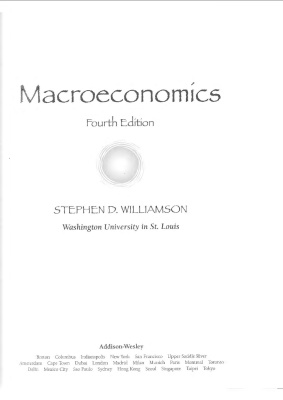(Ebook) Macroeconomics, 4th Canadian Edition by Williamson S.W. ISBN 9780131368736, 9786176713449, 6176713447, 0131368737
For intermediate macroeconomics courses.The Williamson text provides a modern approach to macroeconomics in which core economic theory is explained with a focus on the micro foundations.Features:Real-world applications.applications to current and historical problems are emphasized throughout in two running features. These real-world applications relating directly to the theory encapsulate ideas from frontline research in macroeconomics and the history of economic thought, and they aid students in understanding the core material.Art program.graphs and charts are plentiful in this book. They act as visual representations of macroeconomic models that can be manipulated to derive important results and show the key features of important macro data in applications. To aid the student, graphs and charts use a consistent two-colour system that encodes the meaning of particular elements in graphs and of shifts in curves.End-of-chapter summary and list of key terms.each chapter wraps up with a summary of its key ideas, followed by a glossary of key terms. The key terms are listed in the order in which they appear in the chapter, and they are highlighted in bold typeface where they are first explained within the chapter.Questions for review.these questions are intended as self-tests for students after they have finished reading the chapter material. The questions relate directly to ideas and facts covered in the chapter, and answering them will be straightforward if the student has read and comprehended the chapter material.Problems.the end-of-chapter problems will help the student in learning the material and applying the macroeconomic models developed in the chapter. These problems are intended to be challenging and thought provoking.Mathematics and mathematical appendix.in the body of the text, the analysis is mainly graphical, with some knowledge of basic algebra required; calculus is not used. However, for students and instructors who desire a more rigorous treatment of the material in the text, a mathematical appendix develops the key models and results more formally, assuming a basic knowledge of calculus and the fundamentals of mathematical economics. The Mathematical Appendix also contains problems on this more advanced material.New to this edition:• Chapter 5 - new material on the optimal choice of government spending.• New Chapter 6 —featuring the innovative and 2010 Nobel prize-winning Diamond-Mortensen-Pissarides search model for unemployment. This model allows the student to understand recent events in labour markets in North America and the rest of the world, along with the key determinants of the unemployment rate, the vacancy rate, and labour force participation.• Split Chapter 8 into 2 chapters on financial crisis and recession.• New Chapter 9 examines credit market frictions related specifically to the global financial crisis and social security programs.• Chapter 12- expanded material on currently popular topics: nominal Gdp targeting, the zero lower bound, liquidity traps, and quantitative easing.• Chapter 13 - new material on New Monetarist Economics.New end-of-chapter problems.
*Free conversion of into popular formats such as PDF, DOCX, DOC, AZW, EPUB, and MOBI after payment.


